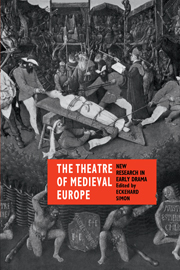Book contents
- Frontmatter
- Contents
- List of contributors
- Preface
- Note on the bibliography and system of references
- List of abbreviations for journals and series
- 1 Introduction: trends in international drama research
- PART I LATIN DRAMA
- PART II ENGLISH DRAMA
- PART III CONTINENTAL DRAMA
- 9 France
- 10 Italy: liturgy and christocentric spirituality
- 11 Spain: Catalan and Castilian drama
- 12 Germany and German-speaking central Europe
- 13 The Low Countries
- Bibliography
- Author index to the bibliography
- General index
12 - Germany and German-speaking central Europe
Published online by Cambridge University Press: 29 March 2011
- Frontmatter
- Contents
- List of contributors
- Preface
- Note on the bibliography and system of references
- List of abbreviations for journals and series
- 1 Introduction: trends in international drama research
- PART I LATIN DRAMA
- PART II ENGLISH DRAMA
- PART III CONTINENTAL DRAMA
- 9 France
- 10 Italy: liturgy and christocentric spirituality
- 11 Spain: Catalan and Castilian drama
- 12 Germany and German-speaking central Europe
- 13 The Low Countries
- Bibliography
- Author index to the bibliography
- General index
Summary
When looking at the substantial corpus of medieval plays from German-speaking central Europe, it is not easy to come up with an exact tally. If we mean plays written in German – that is, in the various dialects of medieval German – the total would run to about 162 religious plays and 155 plays on secular themes, mostly short Carnival comedies. However, there are another 32 religious plays written mostly in Latin but containing passages of German verse. In addition, the area produced 53 surviving religious plays in Latin, some, like the Antichrist play of Tegernsee (c. 1160), major documents of the medieval stage. German playwrights, mainly men of the Church, were not alone, of course, in frequently writing their plays in Latin, especially during the early period (eleventh to thirteenth centuries). But the number of such plays, sung in churches, is especially large in this region. Lipphardt's comprehensive collection contains about 655 liturgical Easter plays, called ‘Easter offices’ (Osterfeiern) by German scholars because they were performed as part of divine services. More than four-fifths of these, numbering some 528 texts, originated in religious houses of German-speaking central Europe (the old Empire or Reich), which is a fact that has been but rarely noted.
- Type
- Chapter
- Information
- The Theatre of Medieval EuropeNew Research in Early Drama, pp. 207 - 224Publisher: Cambridge University PressPrint publication year: 1991
- 2
- Cited by

